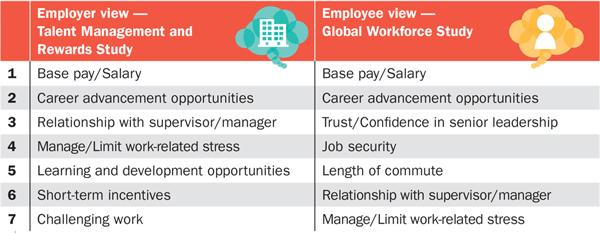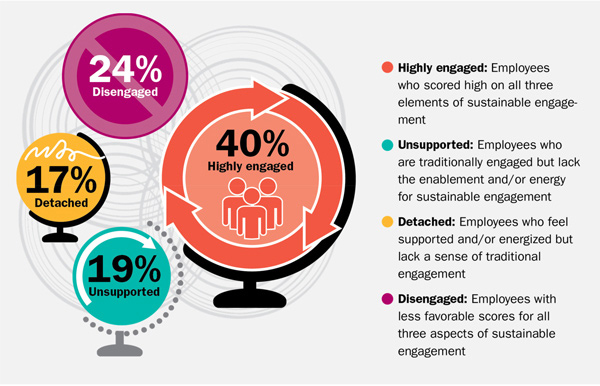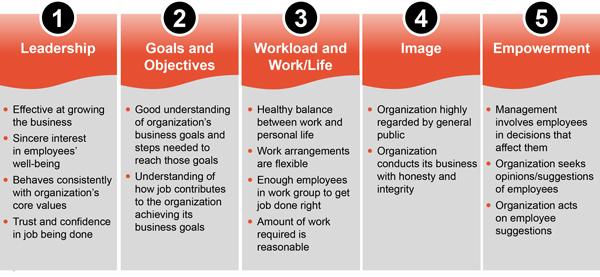How the 2014 Global Workforce and Global Talent Management and Rewards Studies relate to sustainably engaged employees
This issue of Sustainably Engaged focuses on current global trends in employee attraction, retention, and engagement from both the employee and employer perspectives. The insights were gleaned from the 2014 Global Workforce Study (GWS) and the 2014 Talent Management and Rewards Study (TM&RS), both recently released by Towers Watson. These two studies collectively represent the views of more than 1,600 companies and 32,000 employees from over two dozen markets globally.
Top Drivers of Employee Attraction
We begin by considering the top drivers of employee attraction, as many organizations are finding it increasingly difficult to attract critical talent. For insight on this issue, we asked employees to choose from a list of the top factors that are most important to them when joining a company, and separately asked employers what they believe to be the top issues driving employee attraction. The answers are shown below.

Source: 2014 Towers Watson Global Workforce Study and 2014 Towers Watson Global Talent Management and Rewards Study
As you can see, there is some alignment between the employee and employer views, and also some divergence. Both groups see the importance of base pay and career advancement opportunities, as these issues appear among the top three in both lists. Learning opportunities and the organization’s reputation are also viewed similarly, within the top seven factors, but not among the top three, for both groups.
One clear area of disconnect is the importance of job security. While this is the second most important attraction driver for employees, it ranks seventh on the employers’ list of these drivers. This particular disconnect is a relatively recent phenomenon and has worsened since it first appeared in 2012. At that time, job security was the second most important attraction driver for employees (as it is today), but it was rated fourth most important by employers, suggesting they had greater insight into employees' concerns than they do now. It may be that employers believe job security concerns among employees have decreased with a slowly improving economy, when in fact they have not.
A second area of disconnect involves employers overestimating the importance of company mission, vision and values. While employers believe this is the fifth most important factor in driving attraction, it doesn’t even rank among employees’ top seven. This disconnect does not necessarily indicate that employees do not care at all about a company’s mission, but may instead suggest that potential employers and that only companies with engaging missions are considered for employment.

Source: 2014 Towers Watson Global Workforce Study and 2014 Towers Watson Global Talent Management and Rewards Study
There is strong alignment between employers and employees on the two most important factors influencing retention: base pay and career advancement. Looking further down the list, we can see areas of disconnect. Specifically, employees indicate the third most important driver is trust/confidence in senior leadership, which does not appear at all among employers’ top seven retention drivers. This finding is consistent with a trend Towers Watson has noted before, which is the tendency of many companies to underestimate the impact senior leaders have on employees, and to overestimate the impact of frontline supervisors. In fact, both levels of management play an important role. Similar to what we observed in our examination of attraction drivers, there is a disconnect between employers and employees with regard to job security, with employers underestimating its importance as a retention driver.
While attracting and retaining employees is vitally important, it is employee engagement that is the most consistent predictor of business performance, which is why an understanding of the drivers of employee engagement is so important to most companies. As a reminder, Towers Watson focuses on sustainable engagement, which includes three components:

Source: 2014 Towers Watson Global Workforce Study
Using this three-part formulation, we are able to determine the current percentage of employees who are highly engaged (favorable on all three components) and disengaged (unfavorable on all three components). Further, we can determine the percentage of employees who are “unsupported” (i.e., traditionally engaged but not enabled or energized, or both) and “detached” (i.e., enabled and energized but not engaged). As shown above, current global results indicate that 40% of employees are engaged, while 24% are disengaged. Seventeen percent can be considered detached, compared with 19% who are unsupported. This last group may represent the biggest opportunity, as it reflects employees who generally believe in the company and are willing to work hard on its behalf, but simply do not have the tools to do the job or do not work in a healthy environment (or both).
While it is valuable for an organization to understand the current level of engagement, it is arguably far more important to understand engagement drivers or top statistical predictors of engagement. When we understand the drivers of engagement we can then focus on improving those drivers and, ultimately, improve engagement. To identify the drivers of engagement in the Global Workforce Study, a statistical analysis was conducted that predicts engagement using dozens of questions measuring the full range of employee work experiences. Those questions with the strongest statistical link to engagement are considered to be drivers. The results are depicted below and reveal the following drivers in descending order of impact on engagement: leadership, goals and objectives, workload and work/life, company image and empowerment.

Source: 2014 Towers Watson Global Workforce Study
What this means is that, all else being equal, efforts to improve perceptions of company leadership will likely have a bigger positive impact on engagement than the other drivers. Further, any of these drivers will likely have a bigger impact than those not on this list, for example, perceptions of pay or immediate supervision.
Of course, the results presented here are global trends, and results for a particular company may look different. A company-specific survey remains the only reliable method for determining the drivers unique to each organization. Nonetheless, these results provide a valuable context for interpreting company-specific findings and understanding employee workforce trends more broadly.